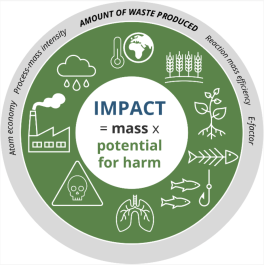Integrating Simple Environmental Impact-Based Metrics into the Undergraduate Curriculum

Summary
The most important learning objective in green chemistry education is the ability to identify the synthesis, process, or chemical that is least environmentally harmful. Existing metrics fall short for different reasons. Mass-based metrics fail to assess environmental harm, while life cycle assessment (LCA) is much too complex to insert into the existing curriculum without displacing a significant amount of content. However, individual environmental impact-based metrics derived from LCA can be easily incorporated into the curriculum with very little instruction time and no significant displacement of content. For first-year or introductory chemistry, we show how typical first-year calculation questions can be expanded to allow students to use an impact-based metric to identify the least harmful of the presented options. For upper-year courses, we propose an activity that scaffolds the LCA process of compiling data, calculating individual impact-based metrics, combining metrics, and using context to make a decision. This activity was implemented using a problem-based learning model to support multivariate reasoning through peer discussions.
The Learning Object is about a teaching tool developed by Jackson de Verteuil, Philip G. Jessop, and Amanda Bongers (Queen's University—Kingston, ON, Canada).
Full Citation:
Integrating Simple Environmental Impact-Based Metrics into the Undergraduate Curriculum
Jackson de Verteuil, Philip G. Jessop, and Amanda Bongers
Journal of Chemical Education 2024 101 (4), 1592-1598
DOI: 10.1021/acs.jchemed.3c01217
The Learning Object is about a teaching tool developed by Jackson de Verteuil, Philip G. Jessop, and Amanda Bongers (Queen's University—Kingston, ON, Canada).
Full Citation:
Integrating Simple Environmental Impact-Based Metrics into the Undergraduate Curriculum
Jackson de Verteuil, Philip G. Jessop, and Amanda Bongers
Journal of Chemical Education 2024 101 (4), 1592-1598
DOI: 10.1021/acs.jchemed.3c01217
Safety Precautions, Hazards, and Risk Assessment
N/A
Other notes/information
The Learning Object is about a teaching tool that was developed by Jackson de Verteuil, Philip G. Jessop, and Amanda Bongers (Queen's University - Kingston, ON, Canada). Being a graduate student working with PGJ, I believe that this tool could be a very good resource to help educators find innovative ways to incorporate mass-based metric systems into the undergraduate curriculum. I had no participation in the writing of the paper, so this LO is to be deemed solely as a resource that I want to share with the community.
Link to external
